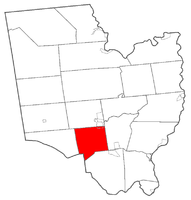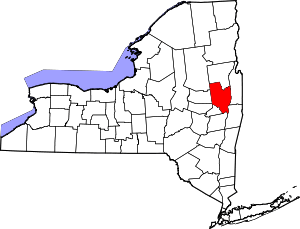Ballston, New York
| Ballston, New York | |
|---|---|
| Town | |
 Location within Saratoga County | |
 Ballston, New York Location within the state of New York | |
| Coordinates: 42°57′12″N 73°52′29″W / 42.95333°N 73.87472°WCoordinates: 42°57′12″N 73°52′29″W / 42.95333°N 73.87472°W | |
| Country | United States |
| State | New York |
| County | Saratoga |
| Area | |
| • Total | 30.0 sq mi (77.7 km2) |
| • Land | 29.6 sq mi (76.7 km2) |
| • Water | 0.4 sq mi (1.0 km2) |
| Elevation | 404 ft (123 m) |
| Population (2000) | |
| • Total | 8,729 |
| • Density | 294.8/sq mi (113.8/km2) |
| Time zone | Eastern (EST) (UTC-5) |
| • Summer (DST) | EDT (UTC-4) |
| ZIP code | 12019 |
| Area code(s) | 518 |
| FIPS code | 36-04220 |
| GNIS feature ID | 0978707 |
Ballston is a town in Saratoga County, New York, USA. The population was 8,729 at the 2000 census. The name is derived from an early settler, Eliphalet Ball, a Presbyterian minister who located there from Westchester County, New York in 1770.[1]
The Town of Ballston is in the southern part of the County and is north of Schenectady.
History
The region was first settled around 1763. In 1775, the area became a District in Albany County.
In 1780, British forces attacked the northern part of the town and took captives back to Canada.
The area was originally called "Ball's Town" and "Ballton." The town was formed in 1785 while still in Albany County. The original owners of the town were the Mcdonald brothers. Rev.Eliphalet Ball from Bedford, New York bought the area of land from them and called it Ball's Town. Ball also paid the brothers 1 barrel of rum for the right to name the town after himself. Over time the name was shortened to Ballston.
Early settlers in this area feared attacks from Mohawks, who already inhabited the region and who resented the establishment of European buildings on their sacred grounds. One of Ballston's historic sites is Indian Rock, a large boulder where Mohawk tribesmen reputedly took white captives (children, in some cases) to torture and kill them.[2]
Ballston Lake, a narrow, 3.7-mile (6.0 km)-long lake with an unknown maximum depth in the south of the region, was called "Shanantaha" by natives. It was known to early white settlers as Long Lake. The lake was part of the Mohawk River during the glacial age and archeological digs have unearthed artifacts indicating settlement around the lake as early as 3,500 BCE.
For a long time the depth of Ballston Lake was not determined, due to the multiple caves that prevented divers from going to the bottom. There has been an artifact found that is dated 2000 B.C. It is also believed that a lake monster, Big Tim, lives within one of the hundreds of caves. Big Tim has been sighted by multiple people.
Geography
According to the United States Census Bureau, the town has a total area of 30.0 square miles (78 km2), of which, 29.6 square miles (77 km2) of it is land and 0.4 square miles (1.0 km2) of it (1.33%) is water.
Ballston is bordered by the Town of Charlton on the west, Milton on the north, Malta on the east, and Clifton Park and a small portion of the Town of Glenville in Schenectady County on the south.
New York State Route 50 (Saratoga Road) is a north-south highway. New York State Route 67 is an east-west highway in the northeast part of Ballston.
Politics
Ballston's supervisor is Patrick Ziegler (R).[3]
Demographics
| Historical population | |||
|---|---|---|---|
| Census | Pop. | %± | |
| 1820 | 2,407 | — | |
| 1830 | 2,113 | −12.2% | |
| 1840 | 2,044 | −3.3% | |
| 1850 | 2,269 | 11.0% | |
| 1860 | 2,234 | −1.5% | |
| 1870 | 2,180 | −2.4% | |
| 1880 | 2,035 | −6.7% | |
| 1890 | 2,059 | 1.2% | |
| 1900 | 2,034 | −1.2% | |
| 1910 | 2,091 | 2.8% | |
| 1920 | 2,206 | 5.5% | |
| 1930 | 2,578 | 16.9% | |
| 1940 | 2,630 | 2.0% | |
| 1950 | 3,969 | 50.9% | |
| 1960 | 5,752 | 44.9% | |
| 1970 | 6,720 | 16.8% | |
| 1980 | 7,714 | 14.8% | |
| 1990 | 8,078 | 4.7% | |
| 2000 | 8,729 | 8.1% | |
| 2010 | 9,776 | 12.0% | |
| Est. 2014 | 10,411 | [4] | 6.5% |
As of the census[6] of 2000, there were 8,729 people, 3,243 households, and 2,425 families residing in the town. The population density was 294.8 people per square mile (113.8/km²). There were 3,388 housing units at an average density of 114.4 per square mile (44.2/km²). The racial makeup of the town was 97.49% White, 0.52% African American, 0.23% Native American, 0.49% Asian, 0.01% Pacific Islander, 0.50% from other races, and 0.76% from two or more races. Hispanic or Latino of any race were 1.33% of the population.
There were 3,243 households out of which 36.4% had children under the age of 18 living with them, 62.6% were married couples living together, 8.9% had a female householder with no husband present, and 25.2% were non-families. 21.2% of all households were made up of individuals and 9.9% had someone living alone who was 65 years of age or older. The average household size was 2.59 and the average family size was 3.02.
In the town the population was spread out with 26.0% under the age of 18, 5.9% from 18 to 24, 27.7% from 25 to 44, 24.9% from 45 to 64, and 15.4% who were 65 years of age or older. The median age was 39 years. For every 100 females there were 93.4 males. For every 100 females age 18 and over, there were 89.1 males.
The median income for a household in the town was $54,845, and the median income for a family was $61,709. Males had a median income of $44,365 versus $30,918 for females. The per capita income for the town was $24,206. About 3.1% of families and 4.6% of the population were below the poverty line, including 5.4% of those under age 18 and 5.9% of those age 65 or over.
Communities and locations in Ballston
- Ballston Center – A hamlet south of Ballston Spa on NY-50.
- Ballston Creek – The outlet of Ballston Lake, flowing past East Hills.
- Ballston Five Corners – A historic location south of Ballston Spa.
- Ballston Spa – The smaller, southern part of the Village of Ballston Spa.
- Burnt Hills – A hamlet at the southwest end of Ballston Lake on NY-50.
- Ballston Lake – (1) A long, narrow lake in the southeast part of the town, and (2) a hamlet at the south end of the lake, partly in Ballston.
- East Hills – A hamlet on the east town line on NY-67.
- Garrison Manor – A location in the south part of the town, west of Burnt Hills.
References
- ↑ Stone, William Leete (1875). Reminiscences of Saratoga and Ballston. New York: Virtue and Yorston. p. 399.
- ↑ Briaddy, Katherine Q. (2004). Around Ballston Lake. Arcadia Publishing. p. 24.
- ↑ "Saratoga County unofficial election results". Albany Times Union.
- ↑ "Annual Estimates of the Resident Population for Incorporated Places: April 1, 2010 to July 1, 2014". Retrieved June 4, 2015.
- ↑ "Census of Population and Housing". Census.gov. Archived from the original on May 11, 2015. Retrieved June 4, 2015.
- ↑ "American FactFinder". United States Census Bureau. Archived from the original on September 11, 2013. Retrieved 2008-01-31.
External links
- Town of Ballston
- Early Ballston history
- Town of Ballston Community Library's collection on New York Heritage
